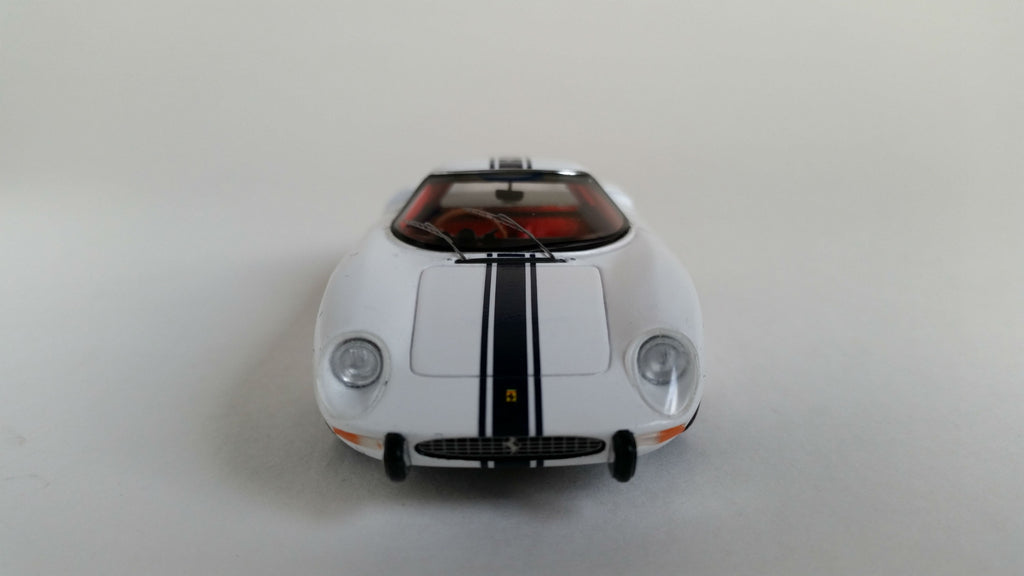

Enzo Ferrari was known to be many things, but flexible was not one of them. Despite getting trounced in Grand Prix racing by upstart British teams and their new mid-engine layouts in the late 1950s, Ferrari clung to the archaic notion that front-engine race cars were a winning formula..."The horse pulls the cart, it doesn't push it," he is reputed to have said. It wasn't until 1961 that the first mid-engine Ferrari Formula 1 racer (the 156) appeared, while in sports car racing the company soldiered on with its front-engined GT cars, the 250 Short Wheelbase and 250GTO.
Still, by the dawn of the 1960s, the future was clear, and its engine was parked behind the driver. International sports car racing at that time carried more prestige than even Formula 1, and Ferrari was forced to find an answer to the coming mid-engine sports car threat. That answer would be the P series of mid-engined prototypes, first launched in 1961 as the 246SP. Only a handful of these early P-cars were built, achieving overall victories at Sebring and the Nurburgring, but Ferrari knew that the key to long-term success of the mid-engine program was to homologate a customer version for privateer racing teams. Thus was born the 250LM, a slippery berlinetta that would carry Ferrari's tried-and-true 3-liter V12 mounted midship.

Use of the 3-liter was critical to the 250LM concept, as it was key to Ferrari's plan to obtain homologation of the new car as nothing more than an evolution of the 250GT line. Under CSI rules, a production run of at least 100 cars was required in order for a car to be classified for GT racing...any fewer, and the car would be considered a Prototype (a much tougher category). Ferrari's hope was that the production output of earlier 250GT and GTO models would count toward the 250LM's total (which, by itself, numbered only around 30 examples) but when CSI officials showed up in Maranello to inspect the new car, it was readily apparent that the 250LM was a radical departure from earlier front-engined efforts. Unless 100 examples of the LM itself could be produced, the car would be branded as a prototype and thrown into battle with more powerful machinery at Le Mans and the rest of the international sports car circuit...poison to customer sales.

With interest from privateer racers insufficient to justify a 100-car production run, Ferrari looked to the manufacture of a street version of the 250LM to jump-start sales. To develop a "stradale" variant, Ferrari plucked serial number 6025 off the assembly line and sent it back to coachbuilder Pininfarina for a few revisions. To make the temperamental mid-engined racer into a livable road car, Pininfarina's first order of business was to lengthen the car's wheelbase for enhanced handling stability and more interior space. Passenger comfort was further improved with the usual application of leather and carpeting, but also with the introduction of removable roof panels for easier access to the cockpit. Painted a luminescent white with a subtle blue stripe (not coincidentally the national racing colors of the United States, the target market for the luxed-out street racer) Pininfarina's 250LM Stradale was unveiled at the 1965 Geneva Motorshow. The 250LM Stradale was a stunner...but perhaps too exotic for its time. No orders were generated for the Stradale, leaving S/N 6025 as a one-off show car, a mere suggestion of an alternate reality in which Ferrari (and not Lamborghini with their Miura) could claim credit for the creation of the modern supercar. As such, the 250LM Stradale is a fascinating footnote in Ferrari's illustrious 70-year history.
Model Citizen is proud to offer a handcrafted 1:43-scale resin replica of the Ferrari 250LM Stradale, by Looksmart. Click here for more information or to order.
